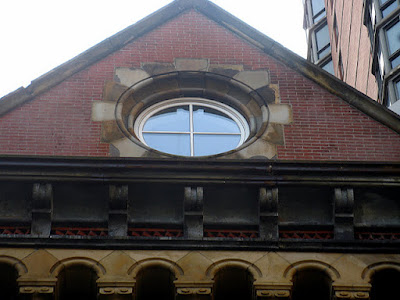 |
| Crooks' austere design reflected the Germanic heritage of the congregants. |
By 1860 the German population in New York City had topped 100,000. There were 20 German churches, two German-language newspapers, and fully 50 schools were taught in German. Already the Lower East Side neighborhood around Third Avenue and the Bowery was becoming predominately German.
But a few of the immigrants struck out for the Yorkville area sixty blocks north where development was just beginning; away from the crowded conditions downtown. In 1863 a congregation of Lutherans established Die Evangelisch Lutheraner Immanuelsgemeinde Ungeaenderter Augsburger Konfession zu Yorkville. It was a name that did not easily roll off the tongue and would be known as Immanuel Lutheran Church.
The group erected its first church on East 87th Street, but within two decades was ready for a substantial new church. English-born architect Arthur Crooks was commissioned to design the building. Crooks had established his reputation in designing many ecclesiastical structures in New York and Connecticut, mostly for Roman Catholic parishes. Immanuel Lutheran Church would be one of Crooks’ last works. He unexpectedly died in December of 1888.
Land was purchased at the southwest corner of East 88th Street and Lexington Avenue. For inspiration the architect looked to contemporary German and Northern European churches—severe Gothic structures with dignity and strength.
At 1:30 on October 31, 1885 an imposing ceremony marked the cornerstone laying. After a short service in the 87th Street church, about 700 congregants marched to the construction site where the basement and a small portion of the exterior walls had been completed.
At 1:30 on October 31, 1885 an imposing ceremony marked the cornerstone laying. After a short service in the 87th Street church, about 700 congregants marched to the construction site where the basement and a small portion of the exterior walls had been completed.
Despite the cold, nearly 1000 people shivered through the three hour service. Inside the polished granite stone were placed an English and a German Bible, a collection of German hymns and other documents relating to the history and current members of the church.
The New York Times promised that the $90,000 building would “be in the Gothic style of Maine granite, with limestone trimmings and with massive buttresses.”
The article got everything right except the buttresses. The completed Immanuel Lutheran Church was both austere and powerful. A 200-foot bell tower anchored the corner of the building and provided its main focal point. The “massive buttresses,” owing to the restrictions of the plot, were scaled down.
In celebration of the building’s dedication, Empress Auguste Victoria of Germany donated three bells for the tower. The empress, wife of Emperor Wilhelm II, would be the last of the German Empresses. The large bronze bells were cast in 1886 by G. E. Gollen von C. Dob & Son in Stettin, Germany. Referring to verse 13:13 in 1 Corinthians—“And now these three remain: faith, hope and love. But the greatest of these is love.”—the bells were inscribed “Glaube, Hoffnung, and Liebe;” Faith, Hope, Love.
Inside, the church stretched 100 feet to the back wall and soared 75 feet to the vaulted plaster ceiling. The large space could seat 1,200 worshipers.
Around 1900 an elaborately carved reredos from the Black Forest area of Germany was installed. The magnificent work became the focal point of the apse with nearly life-sized wooden sculptures of Christ, Moses and John the Baptist standing within complex Gothic canopies.
 |
| The magnificent reredos, from about 1900, was carved in the Black Forest -- photo nycago.org |
The 20th century brought difficulties for German congregations. The General Slocum disaster in 1904 that decimated the congregation of St. Mark’s Evangelical Lutheran Church on East 6th Street drove most of the Germans from that neighborhood to Yorkville. World War I and II brought with them a bias and suspicion against things German, and churches like Immanuel Lutheran struggled through years of uncomfortable tension.
The church underwent a renovation in 1953; but there would be a much greater rebuilding project in store.
In late Spring of 1969 Gimbels Department Store began construction of its new Gimbels East branch on Lexington Avenue between 86th and 87th Streets. As crews dynamited bedrock for the foundation, the church trembled. Ann Siemer, church secretary, notified the general contractor, Conforti & Eisele, and then the sub-contractor, the LeMura Contracting Company, telling them that plaster was falling from the church ceiling.
“Every time I heard a blast,” Siemer told reporters, “I felt a slight tremor in the church.”
The blasting continued and then, on the morning of June 20, the tremors became a disaster. The vaulted plaster ceiling collapsed. The entire east side of the interior was buried in plaster and wooden laths, destroying the pews and damaging the stained glass windows beyond repair. Neither the altar nor the irreplaceable reredos was harmed.
 |
| The exposed beams were kept as architectural design in the restoration -- photo Immanuel Lutheran Church |
In the restoration, the vaulted ceiling was not replaced; instead the open beams and truss work were left exposed. In 1973 replacement windows were installed; the work of Belgian-born New York City artist, Benoit Gilsoul. Gilsoul used faceted glass that gives the windows dimension and diffuses the sunlight.
The Yorkville neighborhood is no longer primarily German. Amid the trendy, upscale atmosphere of the area, however, the sober Immanuel Lutheran Church still stands, anchoring the corner as it has for nearly a century and a half.
non-credited photographs taken by the author








































